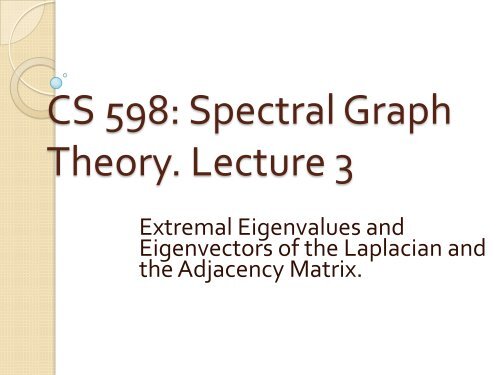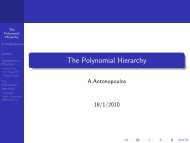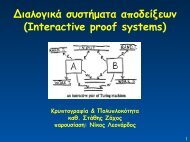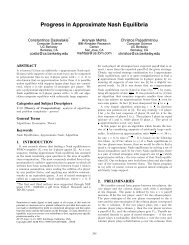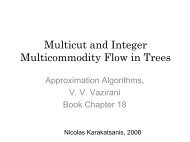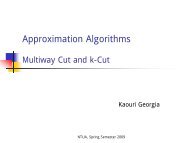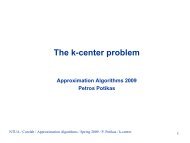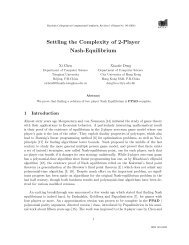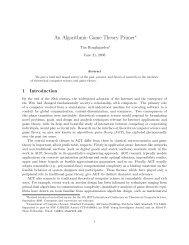CS 598: Spectral Graph Theory: Lecture 3 - Corelab
CS 598: Spectral Graph Theory: Lecture 3 - Corelab
CS 598: Spectral Graph Theory: Lecture 3 - Corelab
You also want an ePaper? Increase the reach of your titles
YUMPU automatically turns print PDFs into web optimized ePapers that Google loves.
<strong>CS</strong> <strong>598</strong>: <strong>Spectral</strong> <strong>Graph</strong><br />
<strong>Theory</strong>. <strong>Lecture</strong> 3<br />
Extremal Eigenvalues and<br />
Eigenvectors of the Laplacian and<br />
the Adjacency Matrix.
Today<br />
• More on Courant-Fischer and Rayleigh<br />
quotients<br />
• Applications of Courant-Fischer<br />
• Adjacency matrix vs. Laplacian<br />
• Perron-Frobenius
Courant-Fischer Refresher (1)<br />
•<br />
<br />
<br />
<br />
k SR<br />
n ,dim( S ) k<br />
x S<br />
<br />
max<br />
min<br />
min<br />
max<br />
k SR<br />
n ,dim( S ) nk1<br />
x S<br />
T<br />
x Ax<br />
T<br />
x x<br />
T<br />
x Ax<br />
T<br />
x x
Sylvester’s Law of Inertia<br />
•<br />
<br />
<br />
max<br />
min<br />
k SR<br />
n ,dim( S ) k<br />
x S<br />
T<br />
x Ax<br />
T<br />
x x
Courant-Fischer Refresher (2)<br />
•<br />
<br />
k<br />
<br />
min<br />
S of dim k<br />
max<br />
xS<br />
T<br />
x Lx<br />
T<br />
x x<br />
<br />
k<br />
max<br />
S of dimnk1<br />
min<br />
xS<br />
T<br />
x Lx<br />
T<br />
x x
Courant-Fischer for Laplacian<br />
• Applying Courant-Fischer for the Laplacian<br />
we get :<br />
<br />
<br />
2<br />
max<br />
min<br />
x1,<br />
x0<br />
<br />
1<br />
0,<br />
v 1<br />
1<br />
T<br />
x Lx<br />
<br />
T<br />
x x<br />
min<br />
x1,<br />
x0<br />
T<br />
x Lx<br />
max max<br />
x0<br />
T<br />
x x x0<br />
S of dim k<br />
• Useful for getting bounds, if calculating spectra is cumbersome.<br />
• To get upper bound on λ2, just need to produce vector with small<br />
Rayleigh Quotient.<br />
• Similarly, t o get lower bound on λmax, just need to produce vector<br />
with large Rayleigh Quotient<br />
<br />
( i,<br />
j)<br />
E<br />
<br />
( i,<br />
j)<br />
E<br />
( x<br />
<br />
iV<br />
( x<br />
<br />
iV<br />
i<br />
i<br />
x<br />
x<br />
2<br />
i<br />
x<br />
x<br />
2<br />
i<br />
j<br />
j<br />
)<br />
)<br />
<br />
2<br />
2<br />
k<br />
<br />
min<br />
max<br />
xS<br />
T<br />
x Lx<br />
T<br />
x x
Example 1<br />
• Lemma1: Let G=(V,E) be a graph with some<br />
vertex w having degree d. Then<br />
max<br />
d<br />
• Lemma 2: We can also improve on that. Under<br />
same assumptions, we can show:<br />
max<br />
d 1<br />
Proof: see blackboard
Example 1<br />
• Lemma1: Let G=(V,E) be a graph with some<br />
vertex w having degree d. Then<br />
max<br />
d<br />
• Lemma 2: We can also improve on that. Under<br />
same assumptions, we can show:<br />
max<br />
d 1<br />
Lemma 2 is tight, take star graph (ex)
Example 2<br />
• The Path graph Pn on n vertices has<br />
<br />
2<br />
12<br />
<br />
2<br />
n<br />
• Already knew that, but this is easier and more<br />
general.<br />
Proof: see blackboard
Example 3<br />
•<br />
2<br />
<br />
2<br />
n
Example 3<br />
node 1<br />
node 2 node 3<br />
node 4<br />
node 5<br />
node 6 node 1<br />
0<br />
1 -1<br />
1 -1<br />
1 -1<br />
1<br />
1 1<br />
1 -1<br />
-1<br />
-1<br />
-1
• Lower bounds are harder, we will see<br />
some in two lectures (different<br />
technique)
Adjacency Matrix vs.<br />
Laplacian
Adjacency Matrix Refresher<br />
i<br />
G = {V,E}<br />
j<br />
1, if ( i,<br />
j)<br />
edge<br />
A ij<br />
<br />
0<br />
if no edge between i,<br />
j<br />
j<br />
• Unweighted graphs for simplicity<br />
i<br />
1<br />
A has n eigenvalues (counting multiplicities)<br />
{a1 a2 … an }
Adjacency Matrix vs. Laplacian for<br />
d-regular graphs<br />
•
Bounds on the Eigenvalues of<br />
Adjacency Matrix<br />
•
Bounds on the Eigenvalues of<br />
Adjacency Matrix<br />
•
Courant-Fischer for Adjacency<br />
Matrix Refresher<br />
<br />
k<br />
<br />
max<br />
S of dimk<br />
min<br />
xS<br />
T<br />
x Ax<br />
T<br />
x x<br />
<br />
1<br />
max<br />
x0<br />
T<br />
x<br />
x<br />
Ax<br />
x<br />
T<br />
• Will see next how to apply Courant-Fischer for the adjacency<br />
matrix to get another bound on the first eigenvalue as well as a<br />
relation to graph coloring
Bounding Adjacency Matrix<br />
Eigenvalues<br />
•<br />
<br />
1<br />
max<br />
x0<br />
T<br />
x<br />
x<br />
Ax<br />
x<br />
T
Bounding Adjacency Matrix<br />
Eigenvalues<br />
•
Chromatic Number<br />
•
Chromatic Number<br />
•
Adjacency Matrix: The Perron-<br />
Frobenius Theorem<br />
•
Adjacency Matrix: The Perron-<br />
Frobenius Theorem<br />
• Proof in 3 parts.<br />
• We next show<br />
Lemma 1: If all entries of an nxn<br />
matrix A are positive, then it has a positive<br />
eigenvector v with corresponding positive<br />
eigenvalue α, that is Av=αv.<br />
Geometric proof on blackboard
Adjacency Matrix: The Perron-<br />
Frobenius Theorem<br />
•
Adjacency Matrix: The Perron-<br />
Frobenius Theorem<br />
•
Laplacian: The Perron-Frobenius<br />
Theorem<br />
• <strong>Theory</strong> can also be applied to Laplacians and any<br />
matrix with non-positive off-diagonal entries. It<br />
involves the eigenvector with smallest eigenvalue.<br />
Perron-Frobenius for Laplacians:Let M be a matrix<br />
with non-positive off-diagonal entries s.t. the graph<br />
of the no-zero off-diagonal entries is connected.<br />
Then the smallest eigenvalue has multiplicity 1 and<br />
the corresponding eigenvector is strictly positive.<br />
Proof on blackboard.


